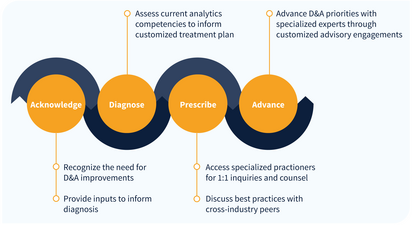Traditional ROI doesn’t capture the full story of analytics value. For a new approach, download our free Practical Guide to Measuring and Communicating the True Value of Analytics to the right, or keep reading to answer the following questions
Jump to section:
- Why doesn’t traditional ROI capture the real value of analytics?
- What’s a better way to define and measure analytics value?
- What makes the RBV framework different from traditional ROI?
- How does the RBV equation actually work?
- Why does strategic fit matter more than technical performance?
- How do you measure value when analytics is federated?
- What does it mean to make smarter bets with analytics?
A Practical Guide to Measuring and Communicating the True Value of Analytics

Why doesn’t traditional ROI capture the real value of analytics?
Most enterprise leaders still default to the ROI question: “What did it cost, and what did we get?” But this classic framing rarely works for analytics. Unlike machinery or software, analytics doesn’t produce fixed outputs—it changes how decisions are made. It creates leverage through insight, not transactions. And the most meaningful returns are often delayed, indirect, or co-owned by business partners who weren’t part of the original delivery. As a result, treating analytics like a standard capital investment misses what matters most: sustained behavior change and long-term enablement.
Traditional ROI models assume clean inputs, defined ownership, and predictable outputs. Analytics breaks all three. A model might improve decisions—but only if it’s adopted. A dashboard might highlight risk—but only if it’s used. Meanwhile, key friction points—like data disputes or unclear KPIs—never show up in a spreadsheet. These blind spots lead to underfunded work, undervalued teams, and overpromised business cases that stall at adoption.
- Analytics enables outcomes—it doesn’t deliver them in isolation
- Traditional ROI ignores adoption, friction, and behavior change
- Many organizations measure delivery, not impact—and it shows
- Value is lost when no one owns results beyond launch
- ROI frameworks must evolve to fit how analytics actually works
Rethinking ROI in Enterprise Analytics Webinar
In this session, IIA Expert and seasoned analytics leader Amit Mohindra shares how to reframe analytics ROI to reflect not just measurable outcomes, but the relationships that sustain them.

What’s a better way to define and measure analytics value?
To move beyond ROI theater, analytics leaders need a new approach—one that matches the complexity of enterprise environments. IIA’s Returned Business Value (RBV) framework offers just that. It replaces formulaic reporting with a multidimensional lens: strategic alignment, commercial benefit, and risk mitigation. Together, these dimensions reflect not only whether an initiative performed—but whether it mattered. Did it serve enterprise priorities? Did it change behavior? Was it sustained?
This perspective requires a shift in how work is structured, not just how it’s measured. The most effective teams manage analytics as a portfolio—not a queue. They prioritize based on sponsor maturity, organizational readiness, and the likelihood of outcome realization. They right-size projects for the conditions they’re walking into. They demand co-ownership from the business, and they track what happens after the launch, not just before it. Value isn’t just delivered—it’s absorbed.
- RBV reframes value around strategy, outcomes, and readiness
- Adoption, not deployment, is where value begins
- Portfolios beat pipelines: prioritize by impact, not just demand
- Business-side sponsorship is essential to realizing returns
- Value friction—like low data fluency or unclear roles—must be addressed up front

What makes the RBV framework different from traditional ROI?
Most ROI models weren’t built for analytics. They work best when value is linear, timelines are fixed, and outcomes are easy to measure. But analytics doesn’t operate in that world. It creates value over time, across functions, and under uncertainty—through better decisions, smarter prioritization, and improved resilience. The RBV (Returned Business Value) framework was designed for this complexity. It doesn’t replace ROI—it refines it for reality.
RBV measures value through three distinct lenses: strategic alignment, commercial benefit, and risk mitigation. Each dimension reflects how analytics actually drives enterprise value—not just in dollars, but in outcomes that stick. Whether you’re building foundational data infrastructure or deploying advanced AI, RBV provides a shared language to evaluate impact, prioritize investment, and reinforce accountability. It’s not a scoring exercise. It’s a mindset shift—from tracking outputs to operationalizing value.
- Designed for complex analytics and AI initiatives—not transactional projects
- Measures value beyond launch: outcomes, adoption, and sustainability
- Aligns analytics priorities with enterprise strategy and risk appetite
- Helps leaders focus not just on what’s feasible, but what’s worthwhile
- Turns abstract impact into structured, defensible value stories

How does the RBV equation actually work?
The heart of RBV is a deceptively simple formula:
RBV = Strategic Value + (Benefit – Cost) × (1 – Risk)
This equation preserves the basic logic of ROI, but adds what traditional models leave out: whether the work aligns to strategy, whether the organization is ready to absorb it, and what could prevent it from paying off. It forces teams to ask better questions from the start.
What are we enabling? What will it take to realize the benefit? What frictions could block it? RBV gives equal weight to relevance and realism. A project can only generate value if it’s tied to what the business actually cares about—and if the team on the ground is equipped to act on the insight. RBV doesn’t penalize strategic investments that take time. It just surfaces the conditions required to make them pay off. And that shift—toward modeled risk, shared accountability, and honest framing—is what makes RBV durable.
- Strategic Value: Does this advance a priority that already has traction?
- Benefit – Cost: Are we accounting for enablement, reuse, and opportunity cost?
- (1 – Risk): How likely is it that we’ll realize the value we forecast?
- Captures “scaffolding” value like platform acceleration and data standardization
- Encourages investment in bets you can win—not just ones that look good on paper
Expert Exchange: AI Use Cases and ROI
Read IIA Expert takeaways from a client conversation about focusing on the right AI use cases and what value they should expect from an investment in a particular capability.
Roundtable Peer Insights: Measuring and Communicating the Value of Analytics and AI Initiatives
Download key themes and peer insights from this discussion on measuring and communicating analytics and AI impact, from establishing clear metrics and expectations to continuous review initiatives.

Why does strategic fit matter more than technical performance?
Analytics doesn’t create value in a vacuum. It creates value when it helps the business do what it already believes must be done. That’s why RBV starts with strategic alignment. It asks whether an initiative supports CEO-level goals, known pain points, or long-range capabilities. If not, even the most elegant model will struggle to gain traction—or stay funded.
Strategic fit is not a checkbox. It’s a filter. It helps analytics teams focus where they can make the biggest difference, not just where they can make the biggest splash. And it helps organizations balance short-term wins with long-term bets—ensuring analytics is always in service of what matters most. With a strong scoring model and shared governance, strategic value becomes a compass for where to invest and where to say no.
- Projects are scored across tiers—enterprise-level, function-linked, or tactical
- Strategic scoring guides prioritization, not just validation
- Helps prevent shadow projects, duplication, and resource dilution
- Creates a shared language between analytics and business sponsors
- Makes room for foresight—not just retroactive justification

How do you measure value when analytics is federated?
Federated analytics offers undeniable advantages: faster insights, stronger domain alignment, and more responsive delivery. But these benefits often come at a hidden cost—visibility. When delivery is distributed, no single team owns the impact story. Without intentional design, even high-performing initiatives can go underrecognized, undermeasured, and underfunded. Measurement in a federated model isn’t just a reporting function—it’s an operating principle.
Leading organizations are solving this challenge by building measurement into the way work gets prioritized, delivered, and reviewed. Project intake begins with ROI hypotheses and sponsor commitment—not just backlog tickets. Impact is framed in operational terms, like time-to-insight or P&L contribution, and tracked through service-level agreements. Standardized processes, consistent expectations, and business co-ownership help ensure that analytics outcomes don’t just happen—they’re proven, socialized, and sustained. This approach reframes value not as a retrospective exercise, but as a precondition for doing the work.
- Embed value hypotheses into intake processes to ensure business accountability
- Standardize documentation, design norms, and ROI requirements across domains
- Track insight delivery using SLAs tied to business deadlines and financial impact
- Align analytics goals with enterprise scorecards to strengthen strategic relevance
- Reinforce shared ownership through culture—not just governance frameworks
Measuring the Success of Federated Analytics
In IIA’s view, federated analytics is the optimal end-state for mature (or maturing) organizations. What are the key measures of success when implementing the federated analytics model?

What does it mean to make smarter bets with analytics?
At their best, analytics initiatives aren’t just deliverables—they’re bets. Strategic, high-potential, high-uncertainty investments that aim to reshape how the business performs. These bets rarely come with complete information. Instead, they depend on directional estimates, realistic planning, and most importantly, shared ownership. In this context, traditional ROI math won’t cut it. What matters isn’t just the projected benefit—it’s the quality of the bet and the strength of the commitment behind it.
The Returned Business Value (RBV) framework helps leaders structure these bets. It forces clarity: What’s the business case, who owns the upside, and what could derail it? Done well, this process builds rigor into planning, not just measurement. Over time, it also builds discipline. The best bet-makers—those who scope responsibly, engage cross-functionally, and deliver real outcomes—earn the right to take on bolder, more strategic work. The result? Less guesswork, fewer stalled initiatives, and more visible business impact.
- Anchor every initiative to a committed sponsor and success criteria
- Quantify benefit, cost, and risk—even when estimates are directional
- Reward teams that consistently scope, deliver, and measure well
- Use failed bets as learning tools, not scapegoats
- Shift from ROI as a scorecard to RBV as a resource allocation strategy
Looking for more?
Realize analytics advancement with IIA


What top ROI questions are IIA Experts fielding right now?
Here’s what your peers are struggling with and how IIA’s Experts helped them make progress.
- How can I prioritize data science projects and estimate their impact—before they’ve even started—to build a high-value roadmap and gain stakeholder buy-in?
- How can we credibly quantify the value of our predictive models to satisfy leadership’s expectations around ROI?
- How can we consistently measure and communicate the ROI of our regional analytics products—especially those with indirect or strategic value—to secure ongoing investment in a hybrid global-local model?
- What methods or tools can help us prioritize the right AI use cases—and estimate their value—within a highly regulated industry?
- How do you tell the value story of a modern data platform that is meant to enable autonomy across an organization?
